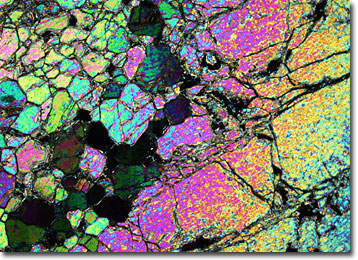Polarized Light Microscopy Digital Image Gallery
Dunite
Dunite is an intrusive igneous rock that dominantly consists of coarse grains of the pale green mineral olivine. When the rock weathers, however, it typically appears a dull yellowish brown color often referred to as dun.

Originally found in the Dun Mountain of New Zealand, dunite was given its moniker by the geologist Christian Gottlieb von Hochstetter in 1859. The rock, which readily degrades into serpentine, is a particularly important commercial source of chromium, but may also contain copper, magnesium, and platinum ores. In fact, the desire to mine and transport the large amount of chromium present in the Dun Mountain led to the creation of New Zealandís first railway system in 1862. Though this railway did not remain in use for long, it is still observed by a large number of people each year who visit the Dun Mountain area to hike along the walking trails that have been established there.
Terrestrially, dunite typically occurs in sills, or horizontal sheets intruded between other rocks, but may appear in other shapes, such as dikes and laccoliths, as well. The formation of the rock, which is a common component of the oceanic lithosphere, is generally believed to arise from the effect of gravity and other forces on accumulations of dense olivine grains. In addition to the massive bodies of the substance in New Zealand, dunite can be found in such diverse locales as Sweden, the Philippines, Alaska, and South Africa.
